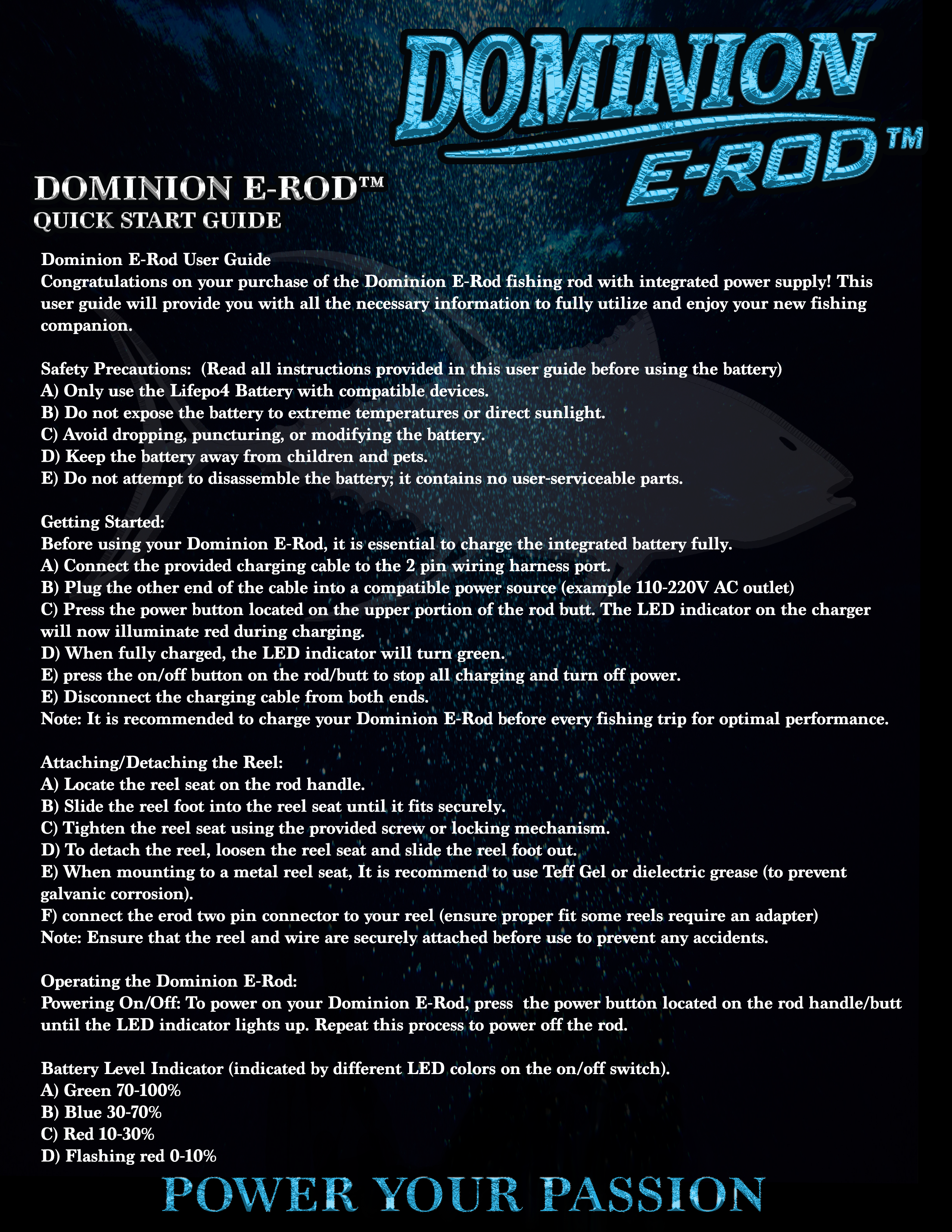WARNING: Users must read both the quick start guide and full manual (located on the bottom of this page) prior to charging & product use to avoid possible injury
**CHARGE FULLY BEFORE FIRST USE**
E-ROD USER MANUAL

E-ROD INSTRUCTION MANUAL
WARNING: Users must read this manual thoroughly to avoid possible injury
Dominion E-Rod User Guide
Congratulations on your purchase of the Dominion E-Rod fishing rod with integrated power supply! This user guide will provide you with all the necessary information to fully utilize and enjoy your new fishing companion.
Safety Precautions: (Read all instructions provided in this user guide before using the battery)
A) Only use the Lifepo4 Battery with compatible devices.
B) Do not expose the battery to extreme temperatures or direct sunlight.
C) Avoid dropping, puncturing, or modifying the battery.
D) Keep the battery away from children and pets.
E) Do not attempt to disassemble the battery; it contains no user-serviceable parts.
Do not charge unattended! The user must have an appropriate understanding of the potential dangers of lithium batteries before purchase and usage. No expressed or implied guarantee of compatibility, suitability, or fitness for any particular purpose or device can be made.
DO NOT USE WITH UNPROTECTED DEVICE
ALWAYS USE A PROTECTIVE CASE OR BOX FOR STORAGE AND TRANSPORT
BATTERIES MAY EXPLODE, BURN, OR CAUSE A FIRE IF MISUSED OR MISHANDLED
ONLY use with proper protection circuitry
DO NOT short circuit intentionally or unintentionally
DO NOT use if battery housing (rod butt) is damaged
DO NOT modify, disassemble, puncture, cut, crush, or incinerate
DO NOT expose to liquids or high temperatures
KEEP AWAY from pets and children
ALWAYS charge in or on a fire-proof surface and never leave batteries charging unattended
ONLY use a smart charger designed for this specific type of battery
STOP immediately if while charging/storing/using the battery it emits an unusual smell, feels hot, changes color or shape, or appears abnormal in any way
It is your responsibility to determine that your charger or device is functioning properly
If exposed to battery electrolyte, flush with water immediately and/or immediately contact a physician or emergency services
DO NOT throw away in the trash; contact your local jurisdiction for proper recycling or disposal
Getting Started:
Before using your Dominion E-Rod, it is essential to charge the integrated battery fully.
A) Connect the provided charging cable to the 2 pin wiring harness port.
B) Plug the other end of the cable into a compatible power source (example 110-220V AC outlet)
C) Press the power button located on the upper portion of the rod butt. The LED indicator on the charger will now illuminate red during charging.
D) When fully charged, the LED indicator will turn green.
E) press the on/off button on the rod/butt to stop all charging and turn off power.
E) Disconnect the charging cable from both ends.
Note: It is recommended to charge your Dominion E-Rod before every fishing trip for optimal performance.
Attaching/Detaching the Reel:
A) Locate the reel seat on the rod handle.
B) Slide the reel foot into the reel seat until it fits securely.
C) Tighten the reel seat using the provided screw or locking mechanism.
D) To detach the reel, loosen the reel seat and slide the reel foot out.
E) When mounting to a metal reel seat, It is recommend to use Teff Gel or dielectric grease (to prevent galvanic corrosion).
F) connect the erod two pin connector to your reel (ensure proper fit some reels require an adapter)
Note: Ensure that the reel and wire are securely attached before use to prevent any accidents.
Operating the Dominion E-Rod:
Powering On/Off: To power on your Dominion E-Rod, press the power button located on the rod handle/butt until the LED indicator lights up. Repeat this process to power off the rod.
Battery Level Indicator (indicated by different LED colors on the on/off switch).
A) Green 70-100%
B) Blue 30-70%
C) Red 10-30%
D) Flashing red 0-10%
4.1 Cleaning and Storage: Proper maintenance ensures longevity and optimal performance of your Dominion E-Rod.
A) After each use, rinse the rod with freshwater to remove any salt or debris.
B) Wipe down all components with a soft cloth.
C) Store your Dominion E-Rod in a dry place away from direct sunlight.
D) On occasion add Teff Gel or dielectric grease to all fittings and electrical connections.
4.2 Battery Overview: The Lifepo4 Battery is a high-performance lithium iron phosphate battery designed for long-lasting power supply. When used correctly it offers a higher energy density, longer cycle life, and improved safety compared to other types of batteries. To ensure safe usage of your Dominion E-Rod's integrated battery, please follow these guidelines:
A) Do not expose the battery to extreme temperatures or direct sunlight.
B) Avoid dropping the rod or subjecting it to excessive force.
C) If the battery shows signs of damage or swelling, discontinue use and contact customer support.
D) Only use the provided charging cable and a compatible power source for charging.
E) Disconnect the charging cable once the battery is fully charged.
F) Do not submerge in water.
G) Do not leave rod unattended during charging especially if you suspect any damage to the rod.
H) If rod damage is suspected, inspect the rod thoroughly and store the rod in a safe place. Please have the rod inspected by a certified dealer or service representative.
Trouble Shooting
A) If unit detects a short circuit it may need a hard restart. Simply plug in the provided charger and press the power button on the rod. The rod will run self diagnostic and reset accordingly. If the problem persists there may be water intrusion in the switch ow power cord. Allow the unit to dry thoroughly and repeat the process. If the problem persists please contact us.
B) Unit not charging. Make sure you are using the supplied charger with a 110 ac outlet and pressing the power button on the rod to initiate charge
C) Battery turning off or not lasting. Make sure your reel is within spec of our guidelines and does not draw more than 20 amps of current. Often the reels may be seized or have a locked up drag washer.
For further assistance, please refer to our customer support team or visit our website for additional resources.
Disposal Warning:
Properly disposing of LiFePO4 batteries is crucial for safety and sustainability. Find out how to handle them responsibly here.
Introduction:
Lithium Iron Phosphate (LiFePO4) batteries are a type of rechargeable battery known for their high energy density, long lifespan, and stable performance. However, like all batteries, they require proper disposal when they reach the end of their useful life or if they are damaged or malfunctioning. Improper disposal of LiFePO4 batteries can pose environmental and safety hazards due to the materials they contain. This manual aims to provide guidance on the safe and environmentally responsible disposal of LiFePO4 batteries.
Precautions Before Disposal:
Before disposing of LiFePO4 batteries, take the following precautions:
- Ensure the battery is fully discharged to minimize the risk of short-circuiting or thermal runaway during handling and transportation.
- Inspect the battery for any signs of damage, leakage, or swelling. If the battery is damaged or swollen, handle it with extreme caution and refer to the manufacturer's guidelines for dealing with damaged batteries.
- Wear appropriate personal protective equipment (PPE), such as gloves and safety goggles, when handling batteries to protect against any potential chemical exposure.
Disposal Options:
There are several options for the disposal of LiFePO4 batteries, including recycling, disposal at designated collection points, and professional disposal services. Here are the recommended disposal methods:
- Recycling: LiFePO4 batteries contain valuable materials such as lithium, iron, phosphorus, and other metals that can be recycled. Many municipalities and recycling centers accept LiFePO4 batteries for recycling. Contact your local recycling facility or municipal waste management department to inquire about battery recycling programs in your area.
- Designated Collection Points: Some retailers or manufacturers may offer collection points or take-back programs for used batteries. These programs are designed to facilitate the proper disposal and recycling of batteries, including LiFePO4 batteries. Check with battery retailers, electronics stores, or the manufacturer of the battery for information on available collection points or take-back programs.
- Professional Disposal Services: If you are unable to find a suitable recycling option or collection point, consider engaging professional disposal services specializing in hazardous waste management. These services are equipped to handle the safe disposal of various types of batteries, including LiFePO4 batteries, in compliance with environmental regulations.
Disposal Procedures:
When disposing of LiFePO4 batteries, follow these procedures:
- Package the batteries securely to prevent damage or leakage during transportation. Use non-conductive materials such as cardboard or plastic to insulate the batteries and minimize the risk of short-circuiting.
- Clearly label the package as containing "Used LiFePO4 Batteries" or "Hazardous Waste" to alert handlers to the contents and ensure proper handling.
- Transport the packaged batteries to the designated disposal facility or collection point following any applicable regulations or guidelines for the transportation of hazardous materials.
Environmental Considerations:
Proper disposal of LiFePO4 batteries is essential for minimizing environmental impact and preventing pollution. By recycling LiFePO4 batteries, valuable resources can be recovered, and the risk of hazardous materials leaching into the environment is reduced. Always choose recycling or proper disposal methods over throwing LiFePO4 batteries into regular household waste.
Conclusion:
Disposing of LiFePO4 batteries responsibly is essential for protecting the environment and human health. By following the guidelines outlined in this manual, you can ensure that LiFePO4 batteries are safely and environmentally responsibly disposed of at the end of their useful life. Remember to always prioritize recycling and proper disposal methods to minimize the environmental impact of battery waste. If you have any questions or concerns about the disposal of LiFePO4 batteries, consult with local authorities or environmental agencies for further guidance.
WARNING: This product can expose you to chemicals known to the State of California to cause cancer. For more information, go to http://www.P65Warnings.ca.gov.
